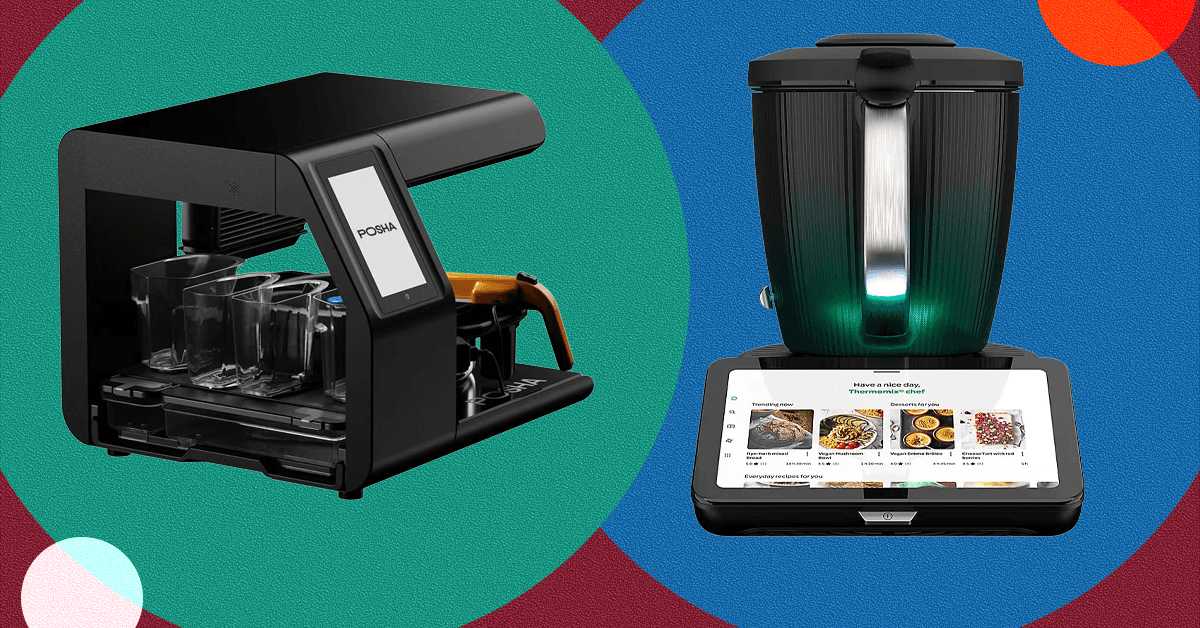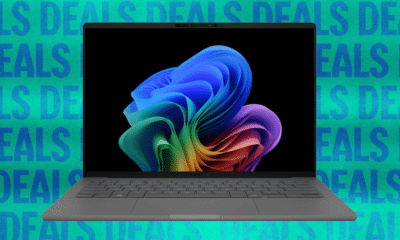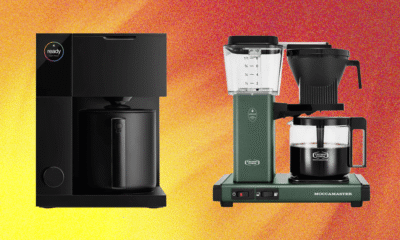Tech
These Beats Headphones Are Marked Down to $150 for Black Friday

Say what you will about Beats fans, but at least they know what they like. These headsets and earbuds are instantly recognizable for their slick styling and bass forward sound profile. If that sounds like your speed, the Beats Studio Pro are currently marked down as low as $150 Amazon, depending on your color preference. I spotted them at the lower price in matte white, sand gray, and dune, with a slightly higher $170 price tag for the remaining colors, though your availability may vary.
While the Studio Pro lack some of the Apple-exclusive features you get with AirPods, for example, the upside is that they’re much more friendly with Android devices. Both platforms get access to one-touch pairing and the helpful Beats app, while iPhone owners also get the benefits of Hey Siri and Find My Device. The other features are a bit of a mixed bag, with a decent battery life of up to 24 hours with ANC on, or 40 with ANC off, but no auto pause when you take them off, or multi-point pairing beyond Google’s Chromebook and Android option.
Like most headphones from Beats, the sound profile is decidedly bass-forward, but Apple’s ownership has tempered that tendency over the last few years. As a result, this generation is more balanced than previous eras, with our reviewer Ryan Waniata complimenting the expansive sound stage and sharp details. Unfortunately, most Beats headsets don’t have any equalizer, and the Studio Pro are no different. For better or worse, you’re stuck with how they sound coming out of the box. These at least support high-resolution audio, up to 24-bit/48-kHz, but only in the wired USB-C mode.
For the Beats enthusiast looking for an upgrade or a second headset for the gym, these are a solid option at a deeply discounted price. They lack some of the richer and more advanced features found on more expensive headsets, but that may be the right compromise for some folks who just want something simple that works every time. If you’re not sure you can stand the bass, make sure to check out all of our favorite wireless headsets.
Tech
MediaWorld Accidentally Sold iPads for 15 Euros. Then It Asked for Them Back

On November 8, an offer for loyalty card holders appeared on the website of MediaWorld, a European electronics retailer. The deal: an iPad Air for 15 euros (about $17) instead of the usual €879 (about $1,012). No catch, no strings attached. The proximity to Black Friday only made the offer more plausible. And so several consumers immediately purchased the product by choosing the “payment and pickup in store” opetion, on paper the safest to avoid unexpected problems.
The process was seamless, even for those ordering online. According to the accounts of some users on Reddit, their order was accepted, and after about 40 minutes they received an email confirming the availability of the product.
In the store, the €15 payment went through successfully and MediaWorld delivered the iPads as expected. The terms and conditions attached to the order make no mention of any clause regarding pricing errors or the possibility for the company to request subsequent additions.
MediaWorld’s About-Face
Eleven days later, however, MediaWorld sent a simple email—not a formal communication via certified mail—stating that the published price was “clearly incorrect.” The company then asked the affected customers to choose between two solutions: Keep the iPad and the difference to match the price but with a €150 discount, or return it and receive a refund of the €15 and a €20 discount voucher for their inconvenience.
MediaWorld’s Response
Following the incident, Wired contacted MediaWorld for comment. “We confirm that, in a very short period of time, due to a clearly recognizable technical error caused by an extraordinary and unexpected glitch on our e-commerce platform, some products were mistakenly displayed at prices that, due to their clear and objective disconnect from the true market value and the correct promotional price, should never have been displayed. This was a manifest error, making it economically unsustainable and not representative of our commercial offering,” a MediaWorld spokesperson explains.
Regarding the subsequent intervention to try to recover the products sold, the representative added: “By virtue of the provisions of the current regulations, we found it necessary to intervene, resorting to a legal principle aimed at preserving the contractual balance in the event of an error of this magnitude. Our approach was to prioritize the relationship with the customer and to offer solutions that went beyond the mere application of law. For this reason, we promptly contacted all affected buyers, proposing two alternatives.”
The MediaWorld spokesperson also confirmed to WIRED the two solutions first highlighted by Reddit users: “We offer product retention: the customer has the option to keep the purchased item, paying the difference between the price paid and the correct promotional price. We have also offered a further discount on the amount to be paid. Or return the product: the customer can choose to return the item free of charge, receiving a full refund of the amount already paid. In this case too, we have offered a MediaWorld shopping voucher. We firmly believe that these proposals demonstrate our willingness to support customers and maintain transparency and fairness. We continue to work to improve our shopping experience and maximum protection for our consumers.”
The Legal Issue: Is the Error Really Recognizable?
On the web, many lawyers point out that Article 1428 of the Italian Civil Code allows a contract to be voided if the error is fundamental and recognizable. But the issue, according to consumer lawyer Massimiliano Dona, is more nuanced than it seems.
“The premise is that the November 19 letter—in which MediaWorld demanded the return or purchase of the iPad at near-real price—is not a formal warning or formal notice, especially if sent by ordinary mail, as it is a proposal for a binary agreement. If the consumer ignores it, MediaWorld will evaluate whether to take formal action,” Dona claims.
“That’s why the key issue is whether, from a legal standpoint, MediaWorld’s claim is well-founded or not. To void a contract, it is necessary to demonstrate the consumer’s awareness of abusing the seller’s error. But to have this proof, it is not enough to claim that the 98 percent discount makes the error obvious in the eyes of the customer.” Furthermore, Dona also points to the fact that, “Today prices are not as standard as they once were. Between limited-time offers, flash sales, promotions, and contests (offered mainly on social or in apps) everything is more variable, plus now we are in the midst of the Black Friday discount season. Given these elements, perhaps we can consider it reasonable that the consumer thought of an advertising technique.”
How Does MediaWorld Test Consumer Awareness?
Dona also claims that there is no threshold beyond which the customer must necessarily notice the mistake: “There are other factors to consider. If the buyer is Mrs. Maria, who finds a deal and decides to take it, that’s one thing. If, on the other hand, it’s someone who buys five tablets and then immediately puts them back on sale, or even someone who resells electronics for a living, that’s another matter. In that case, the awareness of the mistake would be more obvious.”
The decisive issue, he claims, is the recognizability of the error: “From a legal point of view, everything revolves around the buyer’s ability to recognize that the price was incorrect. This is the real deciding factor, which must be contextualized both with respect to sales channel used by MediaWorld and the buyer’s professionalism.”
For now, then, the picture remains an evolving one: a public offer completed without dispute, a U-turn that came days later via email, and a legal assessment that would revolve around whether the consumer was able to recognize the error.
This story originally appeared on WIRED Italia and has been translated from Italian.
Tech
Google’s Black Friday Deals Are Live for Pixel Phones, Nest Hardware, and More
Google Pixel deals abound! The company has kicked off its Black Friday promotions on all of its Pixel hardware, from the value-friendly Pixel 9a to the flagship Pixel 10 Pro XL. There are even discounts on the brand-new Pixel Watch 4 and Google’s wireless earbuds. We’ve rounded up the best Google Pixel discounts this shopping holiday, and even included a handful of deals on Nest hardware if you’re inclined to Google-ify your home.
Check out our Best Early Black Friday Deals for more great deals on WIRED-tested gear.
Featured in this article
Google Pixel Phone Deals
Read our Best Google Pixel Phones guide for more details on these products.
Our top smartphone recommendation for most people, the Google Pixel 9a (9/10, WIRED Recommends) is a steal at $399. You get all the accouterments you’d want in a phone, from wireless charging and a reliable dual-camera system to solid day-long battery life and excellent performance for the money. Google also promises 7 years of software support, which is unmatched at this price, and there’s plenty of fresh software smarts that you’ll find useful every day, like Call Screening, which will cut down the number of spam calls you get.
A much better value than its predecessor, the Pixel 10 (8/10, WIRED Recommends) is one of the few smartphones at its MSRP with a triple-camera system that includes a 5X optical zoom camera. 5X! You can zoom in and capture your kid on stage at the school holiday concert in pristine quality. That makes it an even better buy at $599. Performance is a step up from the Pixel 9a, as is the selfie camera, and there are a few new exclusive software features—like the ability to AirDrop with iPhone owners. It’s the first Pixel (and flagship Android phone for that matter) with Qi2 magnets for faster wireless charging and access to the MagSafe accessory ecosystem.
If you want Google’s best hardware, look no further than the Pixel 10 Pro or Pixel 10 Pro XL (8/10, WIRED Recommends)—the only differences between the two are screen size and battery life. Scratch that, the XL also supports the Qi2 25-watt standard, allowing it to charge even faster from a compatible Qi2 wireless charger. Outside of that, performance goes up a notch from the base Pixel 10 because of the vapor chamber cooling system, which means demanding games will run a little better. The camera quality is sharper , especially the 5X telephoto and primary camera, and you can use Google’s Video Boost technology for better quality video clips. This is the best Google has to offer right now.
Want a folding phone? Google’s Pixel 10 Pro Fold (7/10, WIRED Recommends) is rated to withstand 10 years of folding and is one of the few folding phones with an IP68 dust- and water-resistance rating. (Just, maybe don’t bend it like this.) I can say that I have dropped this phone multiple times on asphalt, and it only has a few scratches on the frame. I think Samsung did a better job with the Galaxy Z Fold7 this year—it’s much thinner and lighter—but the Pixel 10 Pro Fold is still a solid handset if you prefer Google’s software smarts. The cameras are similar to what you’ll find in the Pixel 10, but you don’t get the same great image quality as the Pixel 10 Pro, despite “Pro” in the name.
You don’t always need the latest and greatest. Google has discounted last year’s Pixel 9 series (9/10, WIRED Recommends), though only some of these are worth the money. For example, the Pixel 9 Pro Fold is only $150 less than the Pixel 10 Pro Fold; buy the latter instead. The best deal here is the Pixel 9 at $499, which will still offer a slightly nicer experience over the Pixel 9a, though if you can spare an extra $100, you should opt for the Pixel 10.
Deals on Pixel Cases and Accessories
Check out our Pixel 10 Cases and Pixel 9 Cases guides for more recommendations.
Tech
Two Kitchen Robots Turned Me Into Their Prep Cook for Thanksgiving

The holiday is still almost a week away, and I’m sick of Thanksgiving. I’ve already made four rounds of mashed potatoes, three of mac and cheese, and three turkeys (with more still waiting in my fridge) as part of testing smart probes to help smoke turkeys outside and preparing seven-course holiday meal kits for friends and family.
I was eager to finally outsource some of the cooking by testing two very different robo-chef devices, the Thermomix TM7 and the Posha kitchen robot. Both promise to plan my meals and also do most of the cooking, which sounds pretty good to me.
The Thermomix descends from a German device launched in 1968—a time when the best-known robot chef was cartoon Rosie on The Jetsons—that was essentially a blender with a heater. It’s since caught on big in countries from Italy to Portugal to Australia, and over the years it’s added multi-tier steaming, baking, proofing, a touchscreen, an encyclopedic recipe app, and a whole lot of smart features. WIRED reviewer Joe Ray called 2020’s last-generation Thermomix TM6 (9/10, WIRED Recommends) the “smartest of the smart kitchen.” The newest version, the seventh-generation TM7, was released in August and looks like a giant trophy with a computer screen. It retails for $1,699 and its goal is to replace almost every appliance in your kitchen. It’ll even happily order groceries for you on InstaCart.
The newest robo-chef entrant is Posha, a Silicon Valley-via-Bangalore startup device that aims at truly autonomous one-pot cooking, once you’ve chopped up the proper ingredients into little bins. The Posha kitchen robot was released in January at a price of $1,750 and promptly sold out, as has each successive batch. The device comes complete with a robot stirring arm, and a camera to monitor moisture and browning. Press a button, and Posha will add ingredients at the appropriate moment, spice and stir your food, add water and oil, and cook it down, all without your participation.
I used both the Posha and Thermomix to make a spread of Thanksgiving sides: candied yams, mashed potatoes, mac and cheese, brussels sprouts, and a more complex wild card entry chosen because I thought my Aunt Katherine might like it—and assessed cooking experience overall. Consider it a robo-chef face-off.
Here is my experience with each of the Thermomix and the Posha—and how each fared on five Thanksgiving side recipes.
Cooking Experience With Thermomix
The Thermomix has almost 60 years of history. This is a good thing. It began as, essentially, a blender that can cook. It is still a very powerful blender that can cook. Lord, it makes pesto or mashed potatoes as quickly and easily as anything. I stood by in actual awe of its raw cooking-blending power.
But it’s also evolved into a whole lot more, an all-in-one device that purports to replace just about every appliance in your kitchen. Today’s Thermomix has become a beast of multifarious functionality.
-

 Tech6 days ago
Tech6 days agoNew carbon capture method uses water and pressure to remove CO₂ from emissions at half current costs
-

 Politics1 week ago
Politics1 week agoBritish-Pakistani honoured for transforming UK halal meat industry
-

 Business6 days ago
Business6 days agoThese 9 Common Money Mistakes Are Eating Your Income
-

 Sports6 days ago
Sports6 days agoTexas A&M officer scolds South Carolina wide receiver after touchdown; department speaks out
-

 Business1 week ago
Business1 week agoWhat’s behind Rachel Reeves’s hokey cokey on income tax rises?
-

 Sports1 week ago
Sports1 week agoApple scrapping MLS Season Pass service in ’26
-

 Fashion1 week ago
Fashion1 week agoAfter London, Leeds and Newcastle, next stop Glasgow for busy Omnes
-

 Tech1 week ago
Tech1 week ago$25 Off Exclusive Blue Apron Coupon for November 2025



































